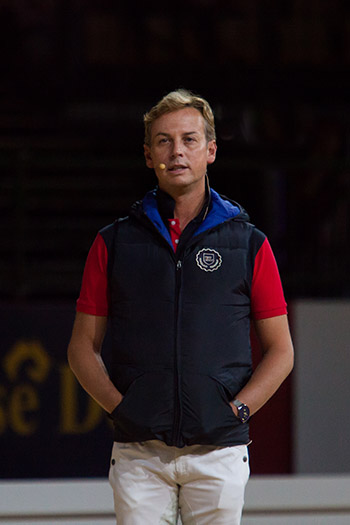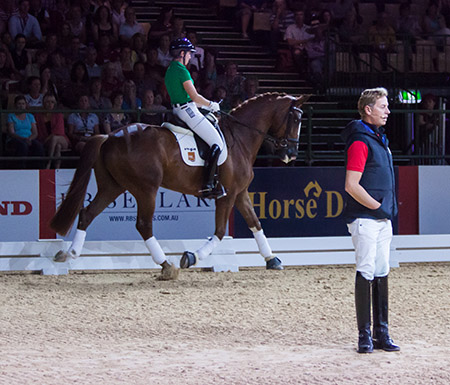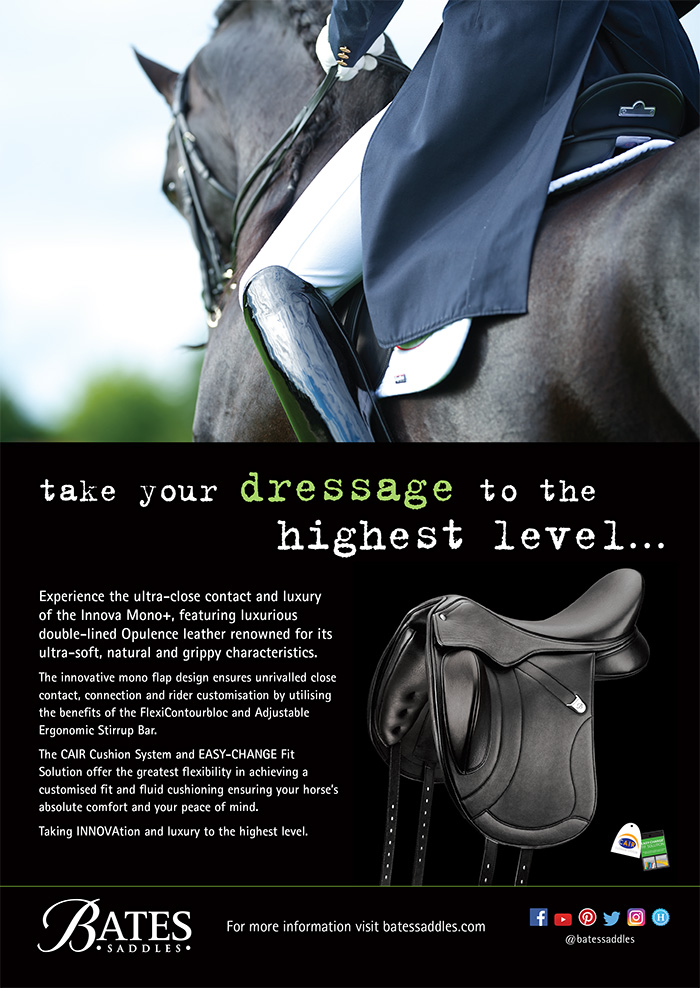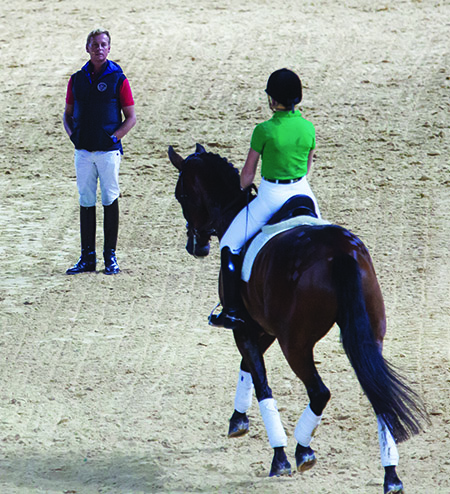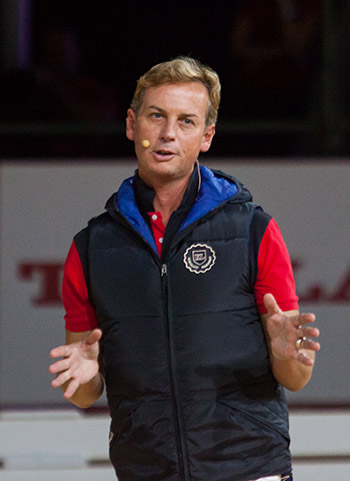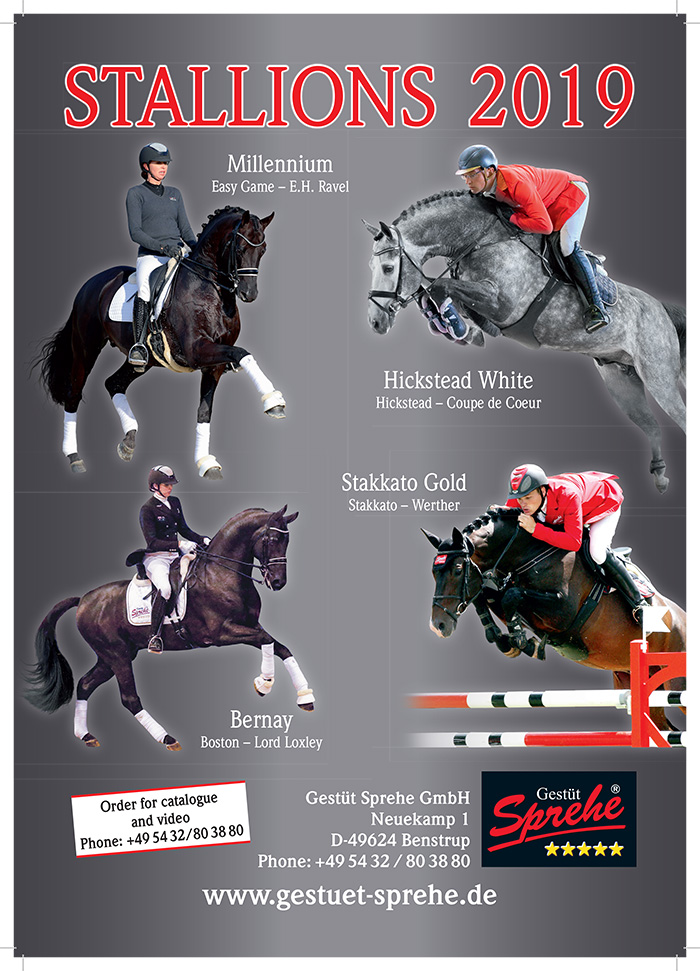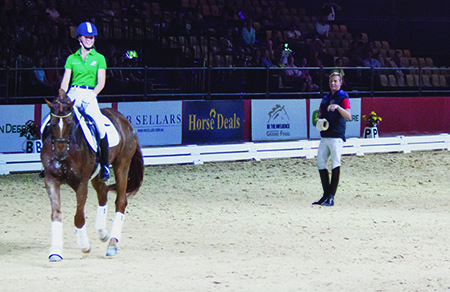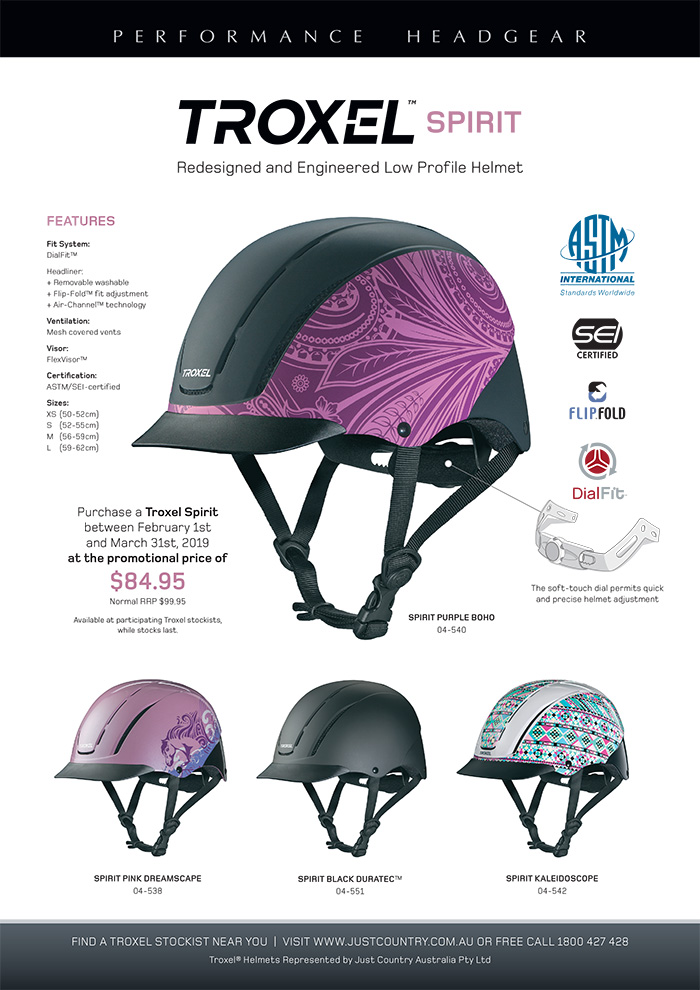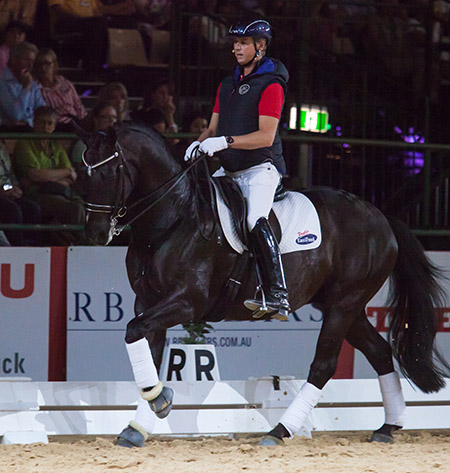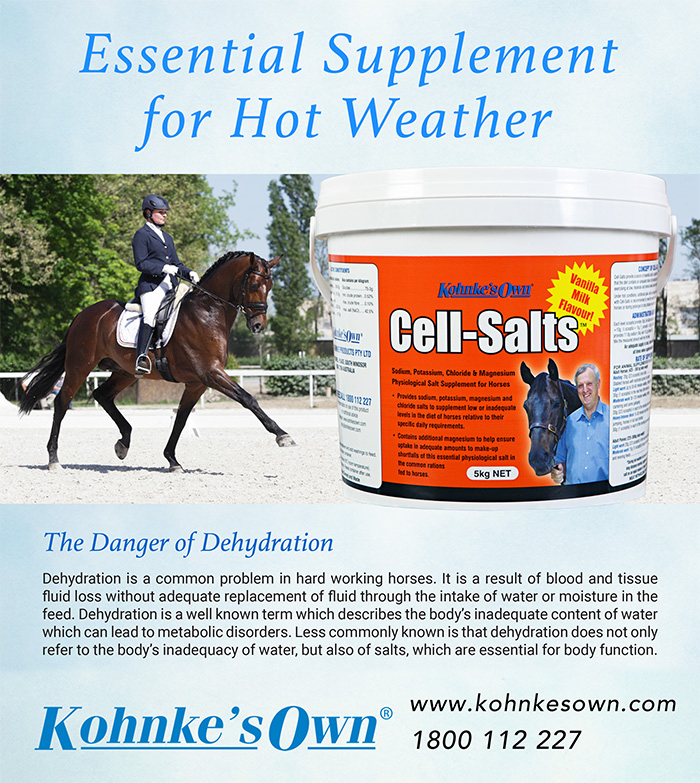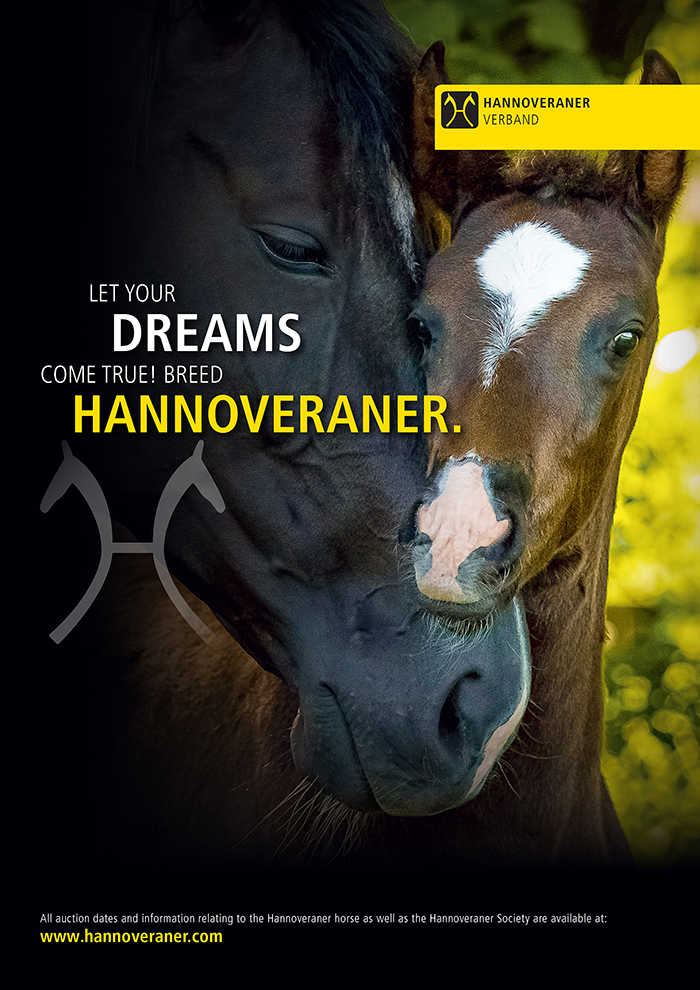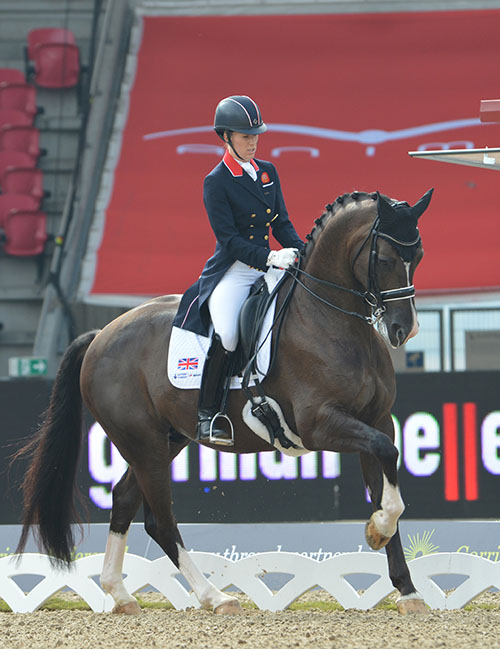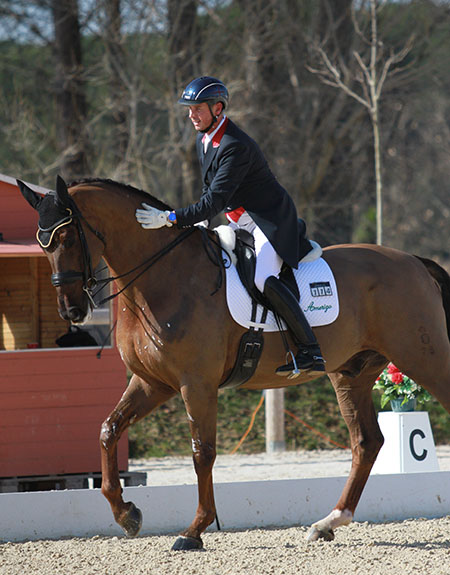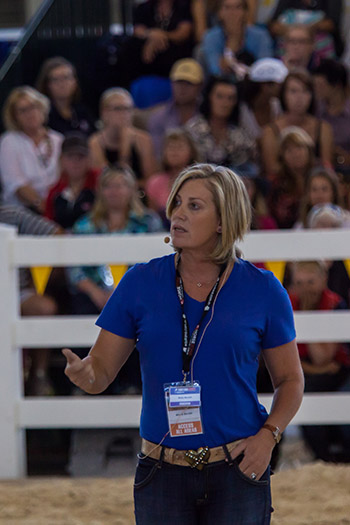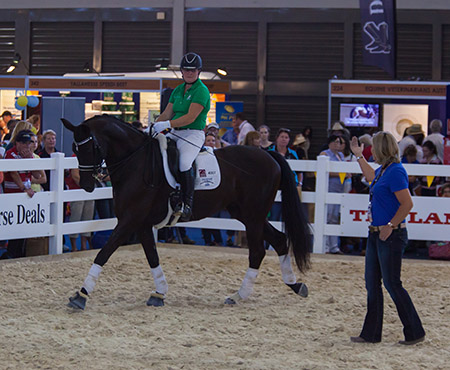Half way through his masterclass at Equitana, Olympic dressage gold medalist and all round nice guy Carl Hester remarked, “I never thought a Brit would be able to help the Australians. I’m quite enjoying it actually!” And help us he most certainly did, with the flair and good humour he’s become famous for.
Carl, with the help of some impressive Aussie riders and horses, took the audience on an express trip through the dressage levels, beginning with what to look for in a dressage horse through to Grand Prix.
First off the blocks was Kate Taylor-Wheat and her super cute Flowervale Florenz. Although not so eager to enter the spooky atmosphere to begin with, the chestnut gelding enjoyed a positive learning experience.
As Kate settled Florenz, Carl explained what he looks for when sourcing a new project, “First thing I look at when I buy a horse is paces rather than breeding. Beautiful parents don’t always produce beautiful children. I’m not looking for the flashiest paces, but also the trainablility and rideability. How are you going to keep a big, flamboyant mover sound into Grand Prix? You want an easy mover. This horse has the first thing on the scale of training: rhythm.”
Kate had to keep her horse quite together and forward at the start. “Kate is quite rightly thinking of safety first. But now we want to look at where he puts his head and neck as he relaxes and becomes more rideable. Always work for relaxation. Then with more stretch his hind leg will be good. Does he look happy? I think he’s looking quite jolly. Kate, show me a rising trot and lengthen the rein,” requested Carl.
It was important that all the horses in the clinic were very easy in their stretching and Carl emphasized how important the warmup is. His horses do about half an hour of hacking and stretching before either he or Charlotte get in the saddle. When Florenz wasn’t stretching, Carl explained further, “He’s curling over away from your hand at the moment. He needs to stretch more. Look behind the saddle at what the tail’s doing. The tail will come up and swing side to side and the back will lift up. Your hand has to come more forward towards his ear, not down, and his neck has to come more out. I want him to unlock himself. I don’t want the flashy movement at this stage. But he shouldn’t curl over and disappear, the body should lengthen and you shouldn’t try to hold the whole thing together.”
Leg yielding was then introduced to work on this and Carl wanted it executed in a rising trot.
“Let him feel like he doesn’t have to carry the rider and do the movement. If his quarters lead, he loses his balance. He fell out because you didn’t control it and let him run sideways. This is why dressage riders love mirrors. The little details and changes make a big difference. You don’t teach the horse to move off your leg by moving its head. You teach it from your leg. You did that well. Kate can feel when it’s right or wrong,” we were told.
more from Carl follows
“Now he stretches better because he works up on the bit. Such a different stretch than in the beginning. You don’t do one round and stop thinking oh I’ve made it. Look how the muscles are now moving in his neck and back. This is a good place to finish.”
Linda Foster’s elementary level Neversfelde Samiro impressed Carl from the start with his super trot, “This is a beautiful horse. Do you know what I like? I like that I can’t hear it on the floor. The hind legs are active and under him”.
Linda then tried the canter, “At the moment he’s a bit up and down with the shoulders in the canter. He needs more reach. Although the trot is good, he’s on the forehand in the canter. Sorry, Linda, no more trot! He needs to be in a more uphill frame. Make the canter small enough so you’re thinking pirouette so he starts sitting. Look low down to the inside hind leg. He should sink here in the fetlock. Look there and not so much the front of the horse. He needs to let down in that fetlock much more.”
Carl suggested that 70-80% of Linda’s training with this horse should be at the canter as the trot was not getting him stronger.
The next focus was on lightness. “Is that your giving?” enquired the Englishman, “In England we say that’s a Scottish give, ‘cause we all know what the Scottish are like! You’re elegant with a good position, but the horse should be more on your seat and less on your hand. Don’t give everything away when you ride forward. Keep him uphill. At this point you must not override. I’d rather see the horse do a mistake. If you’re working this hard now, there’s going to be a hell of a lot of sweat at Grand Prix!”
An exercise to help the horse engage and sit better was leg yield at the canter. Still Carl wanted more sitting, “It was obedient, but not sitting. If you want scores of 70% and above, you need both.”
The risk of mistakes was not a problem and Carl acknowledged how long it can take to get to Grand Prix and the difficulties one can encounter on the way, “If you’re a one horse owner, you know how frustrating it can be if things don’t go well. It can ruin your life, ruin your marriage. But you have to know it’s not always easy.”
Like most of the horses Carl worked with, things started to improve. The horse came lighter on the bit. However, there was still more work for Linda and it was time to tackle control in the corners as Carl explained a helpful exercise:
“Trot up to a corner and halt before it. You have to ride the corners not just free wheel around. This is a good waiting exercise. He has to let you in and let you ride him. This is rideability. Now see if you can ride him around your leg in the corner and it doesn’t feel like the wall of death. You should be looking for his inside eye but not over flexing.”
Like the previous horse this combination finished with a long, stretching trot. “This is your basic stuff. You should be able to stretch him without him running forward.”
next, Lisa Martin and First Famous
Next was Lisa Martin and First Famous. Carl was taken with the stunning mare’s athleticism; regular, engaged with a super shoulder movement, but warned that Grand Prix was a long way off. He also sympathised with us Aussies being so far away, “It’s very promising here at the moment in the lower levels. It must be very difficult living down here. You really do have to go away and train and see ‘out there’”.
It was straight into the movements with Carl reminding that each movement should have; preparation, then maintaining the movement and then riding out of it and around the corner.
When the mare showed a difference on each rein in the shoulder in, Lisa was asked to ride up the centre line, “You need to get control of the right side of the horse. You drifted about a metre to the left. Not too drunk, but a bit! You need to ride shoulder in with no bend because you’re worrying too much about the bend and it’s causing the neck to tip and twist. On the other rein, the horse is more naturally in her curve.”
When it came to travers, Lisa needed to create the angle more with her leg. The exercises, when executed correctly, improved the suppleness of the horse and hence the expression. There was then a warning about neck reining so as not to tilt the mare’s head and instead the rider was encouraged to stand up and step down through her inside stirrup more.
Here was another horse who wanted to run in the stretching trot. Carl was quick to correct and suggested having eyes on the ground as much as possible, “You have to remember every day to do these corrections and not slip back into habits.”
There was just enough time to give the flying changes a go. The horse had only tried them a few times before so Carl went into detail about how hard it is for young horses, and how it probably wouldn’t happen, “The mare is not good at it yet because she’s young. Yesterday one was flying without change, one was a bit of a buck. There were a few variations, but I want Lisa to show you what’s happening in the training right now.”
But with the horse’s superior balance and willing temperament, she offered two perfect changes. “Ah well there you go. She proved me wrong,” Carl conceded with a grin.
The first of the FEI horses was Rombali Razzamatazz with Robbie Soster in the saddle. Carl explained what the main problem was in the warm-up session, “Robbie and the horse are a little bit nervous about taking the contact. She goes shoulder in everywhere, but she needs to be straight so the horse can move forward. I can honestly say, hand-on-heart that straightness is the hardest thing. At least she’s consistently crooked! The horse is in travers left all the time so she rides shoulder in left all the time. If he’s not straight, he can’t carry himself forward and push forward properly.”
Carl was worried about the horse’s slow passage. “This horse is good at sitting but not so good at pushing. At Grand Prix, you need both. Some horses are usually better at one than the other.”
“Let’s get him trotting behind first and try a quicker passage. It’s a different passage, not a Grand Prix passage, but it makes the horse think that it’s got to go forward and move its hind legs more. He has to be on the bit and not like a banana in his back. He must lift his back, but at the moment he’s not on the bit. Instead of sitting there like a fairy on a tree, do something about it, don’t just keep going.”
Robbie had to get the horse relaxed at the higher tempo, then regular passage could be developed. If she just rode the slow passage all the time, problems were sure to develop. Then Robbie was asked to develop the collected trot without losing the suspension she was beginning to create. The horse had to work harder, and Robbie less, “Don’t work so hard! You shouldn’t get off your horse and need to be stretchered away”.
It was a similar message with the one tempi changes. It wasn’t just about getting the movement, but also quality in the movement. “Does he need to learn how to do one-times changes? No, he needs to learn to be straight and jump forward with the hind legs. Let the wall do the work.”
This was a positive change from the previous day Carl told us, “Yesterday she was doing the fastest, highest one-time changes I’d ever seen in my life. I take my hat of to her because she was determined to get them, but now she has to work on the quality. Do this and you’ll be a Grand Prix winner.”
next Carl rides
It was then Carl’s turn to throw a leg over a horse and his mount was Susan Duddy’s DP Weltmieser, Brett Parbery’s Grand Prix ride. Carl was perhaps a bit nervous at the task ahead, “The fact that he’s hot is making me hot! I haven’t ridden and talked for years.”
He began the gelding with a lot of walk/ halt transitions, often halting after one stride of walk, just to feel the control and then it was straight into canter, “Christ, he is hot!”.
Then Carl tried some leg yield in the trot, “This is actually good because it’s making me put my leg on. When they’re hot, you tend not to put the leg on.”
It wasn’t too long before the horse was rewarded with a walk, “If I keep going with these hot horses, then the body gets tired but the brain keeps buzzing so you’re always working a little bit against them.”
Back into the canter again and Carl gave us a lesson in knowing your strides. “How many of you actually know how many strides you ride on the short side? Most of my horses would do between 9-11 steps. I know in a test situation when I’m showing more quality, I’ll go for nine strides. For example, when I canter onto the short side and know I have to do a flying change at A, I know to do the change on the fourth stride. I can make it a positive aid then and not be wondering where the letters are.”
Even though he was hot, he was wanting to back off. In the halt where the gelding wanted to drop the contact, so the problem was addressed quickly so as not to become a habit.
Carl finished on a positive note, “This is actually the kind of horse I like to ride. That’s enough. I have to ride again tonight. Now I have a nice relaxed feeling. I don’t need to go on and show off.”
last horse follows
Last horse into the arena was Lauries As and Tor Van Den Berge. Carl liked the horse’s presence, but warned of ‘stallion issues’, “Breeding stallions need concentration. You know what they’re really thinking about! The other thing is that sometimes they can get sore backs. You have to really think about working the horse soft in his back.”
The focus for this combination was the canter zig zag, and Carl had some interesting exercises.
“Leg yield in canter is for the hotter horse. It’s more relaxing. We do this instead of half passes or zig zag half passes at home. So Tor I want you to canter on the right lead, leg yield, think shoulder in and then flying change. These sorts of exercises stop the anticipation.”
Next the exercise was repeated, but in half pass. Then the difficulty was increased, “Now four lots of six, but only four of the strides are sideways.”
When Tor gave it a go, he missed it because he lost control. “The horse moves more easily to the left so he goes further to the left than the right,” so back to leg yield.
more detail follows
“It’s not all about doing Grand Prix. If you get your horse to Grand Prix at eight years of age, what are you going to do for the next 10 years? It bores most of us, what’s it going to do to them? Hacking, hill work and giving them different exercises like this helps them keep it.”
Lauries As moved on to work in the passage and, the leg yield was introduced once more, “Move the bit and let go. Don’t hold. Looser reins. He’s a stallion and they do get strong in the neck. Leg yield in passage and that will stop him pulling forward. You can let him trail a little bit. He needs to come over and not push away from you.”
There was difficulty in getting a good piaffe/ passage transition, and Carl had a good exercise, “So, to get from passage to piaffe, teach him to do one step of piaffe and then out again. He needs to get stronger in the transition, so doing loads of passage won’t help.”
His final message? “I’d never want to say you should do it my way or I’m right. Just try to find the ability to ride a horse in self carriage.”
CARL’S INTERVIEW
You were happy with the British performance at the Europeans earlier this year?
I was really happy. At Hickstead, it looked like Valegro and Uthopia were coming back into form. Laura’s horse looked great there in the demo, but obviously wasn’t right somewhere along the line. It looked like another gold medal winning team again however, there we go, we lost Laura. I said to Gareth (Hughes, who took Laura’s spot), who’s my pupil anyway, ‘Hang in there, don’t give up.’ The horse went great at Hickstead, he had 72% so a good fourth member if something happened. He got the call up two days before we were due to travel but he coped well; he’s got that Aussie side to him and he was up for it!
Then suddenly we had to be a bit realistic. When we got there, Denmark looked really strong and then there was a chance that they could win the bronze. We all sat down and I said if everyone rides to their best, we could be a bronze medal winning team, but we have to beat Denmark. This was going to be a fight not a walkover. When you think we were all within 1% of the gold with Laura missing, it would have been a walkover with Laura, but that’s how dynamics within teams work.
Gareth’s ride didn’t go so well?
Poor Gareth, the horse worked in great, saw the big screen on the way down to the arena and literally with three minutes to go just freaked out and never got relaxed. As I said to him, there’s two ways of looking at it. We would have won the bronze anyway, relying on Michael, so better to have 60% and a right royal f__k up than get 66% and thought everything had gone great and had no hope for the future. He was cool.
It was a brilliant experience. We got on really well the four of us, so it was nice. And you know, I’ve never won a bronze medal and as I said in the press conference, these two guys, their first time on a team, should be thrilled they got any medal and Charlotte won the Grand Prix anyway. So yippee do, it was happy all round. I thought the Europeans were a big success from the point of view that we had two new riders on the team and they’re our future, aren’t they?
It wasn’t all smooth sailing for Charlotte and Valegro before the Europeans though?
Before the Europeans it was Damon Hill, Damon Hill, Damon Hill. Charlotte had to match her and she was still running on her Olympic success a little bit when she was at Hickstead. There were mistakes and I was like, ‘You’ve got to pull yourself together now. Olympics are done. You’re just thinking that he’s going to do it and you’re not riding.’ So I rang up Hartpury and asked them if we could set an arena up. I wanted to do some test riding with her away from home in a plait up situation. I took her there and it was the same thing. The first time through, there were mistakes. I said to her, ‘Now, you have to realise, the horse is not a computer. He’s offering but you’re just presuming he’s going to do it and you’re not going to win a gold like that.’ I was really hard on her. We went through the test three times until we got it right and for Charlotte, she was very quiet. She didn’t say a word. I really laid it on the line for her. She had to ride better. It worked. It was just what she needed and for the first time ever, that night I got a text from Charlotte saying thank you. I knew she was obviously thinking about it and she had been watching the video of it. I told her to watch it until she was blue in the face. She had one week left, she knew what was going wrong. It was cool.
I made Charlotte watch Damon Hill as well; told her, ‘Google it, watch it. It gets 85%, so what are you going to do? You have to pip it somehow.’ It’s healthy competition. I think Helen’s a lovely person, I think Adelinde’s a lovely person, it’s not about being anti or evil. Those girls are the best at the moment. So watch them. Why are they winning? What are they doing?
I think the competition made Helen ride like Helen’s never ridden before. That Grand Prix at the Europeans when she rode for gold for the Germans, I took my hat off to her and I thought, ‘Good for you. That made you raise your game.’ I’ve never seen the horse go like that. Absolute maximum. She took risks, she deserved it. It was brilliant to watch.
I thought Charlotte’s Grand Prix test was the best test I had ever seen and I’ve seen some of the greats; Rembrandt, Corlandus, all of Isabel’s horses, Bonfire, Salinero and Totilas. I’ve seen them all in action and I’ve seen them all win their golds and I am not biased when it comes to Valegro, I’m harder on Charlotte and Valegro. Even at the Olympics, I still said to Charlotte when she came out of that music, ‘You were lucky. You and I know that was not his best test.’ But I have to say when he came out of that Grand Prix at the Europeans, I thought that was beautiful. He had power and everything I wanted him to have. It had a bit more harmony, a bit more lightness, a bit more engagement and all those things.
You took Uthopia over Fine Time and Dances With Wolves?
I chose Uthopia, not because I had wanted to, because I’d made the decision not to ride him again, which is why Charlotte had started to ride him until the situation sorted itself out (The horse was part of a legal dispute regarding ownership). It shows he’s fit and well and we keep him going.
Carl and Uthopia at the Europeans in 2011
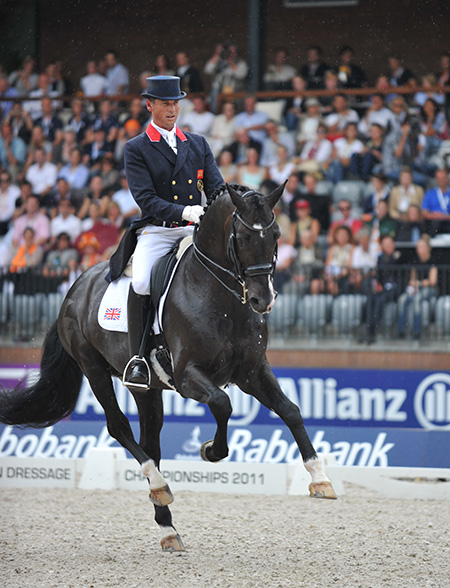
But why wouldn’t you ride him?
Because my pleasure is producing the new ones. Dances with Wolves had a really hard season. I rode him at a lot of shows to try and better his temperament. After Rotterdam, which he did kind of cope with, I still thought, not just yet. The wrong day, the wrong weather, somebody moves in the crowd, he’d just be like, ‘ahhh!’ And he just needed a holiday.
Fine Time has got a lot lot better and I really trust him, but he can’t get the scores that Uthopia can get. And Charlotte was like, ‘One more time! One more time, Grandad! Just do it, Grandad!’
So I thought why not. I can just get on Uthopia, I know him so well, I’ve been riding him for seven years. He was cool. He’s that little bit of stallion, he’s fresh, he’s young so I thought, I’ll take him.
He’ll go anywhere, he doesn’t spook, he doesn’t look, he’ll always do his job. And I thought I have to take him now with Laura not there. The decision was made and it was the right one. And although I didn’t have an amazing ride in the Grand Prix, I got 75%, well Dances With Wolves and Fine Time couldn’t have got that going at their best. Then everyday Uthopia put 3% on his test. I was sixth at the Europeans again. That’s fine! Consistency.
It worked out great and obviously Charlotte was outstanding.
What’s your lead up to WEG looking like?
Uthopia has actually been released to be sold now, so I will be working on that. Fine Time is also to be sold. So that leaves me with Dances With Wolves and another horse, Don Archie who’s nine. I don’t know where we’ll go next year. I think Dances With Wolves will be my only option, but he has to step up to the plate. It’s time. I might take him to Florida early next year, but he’s such a big horse and because of his mentality he needs a lot of riding. He’s not old though and not all of them are going to be top notch at nine, ten, eleven. He might just take a bit longer.
Charlotte will go to Olympia on Valegro to give the British crowds a treat. I’m going to take Fine Time and have a bit of fun. Valegro will definitely go to Normandy.
You won’t sell him then?
You kind of get to the point, I get worried about the fact, will we ever find him a home that does what we do? We only do what we do because we’ve had him his whole life and his value is meaningless in the sense that he’s still a horse and he doesn’t know he’s worth that amount of money so his routine doesn’t need to change. If someone else pays a huge amount for the horse, will they ever let him be a horse? I wouldn’t blame them. I don’t know. We’re working on that and I think over some time, we’ll recoup some money. Whether he’s used for advertising, whether we do a syndicate with someone who wants to come in just because they love dressage. I’m still having meetings about these things all the time. We’re dealing with a racing syndicate manager at the moment who’s helping us piece a programme together that might suit some people. I’m not in any hurry.
I’m going to take a break and we’re going start building now. There’s no pressure anymore. I know Valegro can do it so Charlotte and I will enjoy that.
I really enjoyed riding Dances With Wolves this year. Not the Europeans but my new projects. What comes with maturity is the fact that you realise not everything is going to win the gold medal. So when Fine Time gets 73%, or Dances With Wolves gets 75% in a Special, I’m as ecstatic as winning a gold. That’s maturity, rather than thinking I’ve got to win, I’ve got to win.
But that’s what those gold medals have done. They give you a new lease of life; different expectations. I enjoy competing like this again now. It’s too crazy at the top!
What did you think of the Aussie riders you worked with?
I don’t think we had bad riders. I think we had good riders and I think we had some very nice horses. Lisa’s chestnut mare is very special, very international. Tor’s horse if it gets strong enough. Nice to see little Robbie, a young rider, training her own horse. Cute horse!
I think the main thing is the self carriage. It’s all you really want to do. It’s like everybody is always looking down at the horse all the time. I think sometimes they’re feeling is right, but it doesn’t always look right. It boils down to the fact that we are so lucky to either have mirrors, work with someone else, work with a trainer every week. I don’t think people have access to that here. You can bumble away on your own and think it feels ok and then someone points out that it doesn’t look alright. The horse needs to be more up to the bit. I think the horses here need to be more stretched and more up, not somewhere in between. The horses aren’t really using themselves enough. But I couldn’t be more grateful to get five really easy people. They could do what I asked, they were great to teach and they just soaked it up.
I have the easy job, coming into a clinic where you’ve never seen the horses and riders before. My eye is very much drawn to the fact it’s that and that and that. Fresh eyes. Sometimes when you’re training someone all the time, you get so used to their problems that sometimes they become overlooked because it just hasn’t got better. But if you hit it in a different way because you’ve never seen it before, say it in a different way, they fix it. That’s how it felt to me. I saw the difference and I could see it was very easy to fix. There was no one with really fundamentally bad faults. The horses just weren’t enough in self carriage and the hind legs needed to be further under.
But don’t we all suffer from that? I mean there are problems all over the world like that. Everyone has problems. So there was nothing glaringly awful. It was a really nice clinic and really fun to do. I enjoy it when it’s done. It’s a bit like competing, I dread it and then I do it and then I love it.
So your trip’s been good fun?
It’s fun to be invited to a place like this. You know there are so many things that you lot take for granted that we just enjoy doing by coming here, like sitting on the beach for two days, like going to Mark’s (Dowling) winery, having some sunshine for 10 days. It’s just so lovely.
The nice thing with Equitana is that you’re getting a nice cross section of people. It’s not just dressage people and I think that’s what makes it so much fun with the clinic. Of course it has to be intellectual enough and dressage minded enough, but it’s also about drawing new people in by keeping it a bit basic as well so everyone can understand it. We have YourHorse International in the UK which is like this, so it’s like home away from home.
NICKY BARRETT
Carl’s traveling companion on the long trip to Australia was Nicky Barrett who is another Brit who has had big successes on the international dressage stage. As a rider, she won national titles at every level. She competed to Grand Prix and was reserve rider for the British team at the WEG in Jerez and also won team bronze and silver at European Championships.
As a trainer, she was the British National Team Trainer for young riders before becoming the coach of the Spanish National Young Rider team earlier this year.
Nicky is well known for preparing and introducing young riders to the international dressage circuit and has produced a number of successful combinations to Grand Prix.
When she’s not training, she’s a Grand Prix judge and the dressage commentator for Eurosports.
Her success started when she won bronze at the Pony Europeans, but she learnt to ride the hard way. “I was brought up by my grandmother and she would get ponies for next to nothing at the markets and break them in. She had a very good eye for a horse but had an army background. I was terrified of her!” says Nicky.
“My first horse was Double Trouble. More like Treble Trouble. They said it was unbroken but of course it was broken but nobody could stay on it. Before the days of health and safety, my grandmother would lunge it with an electric fence around it and then I was popped on and this thing used to buck. If I came off it four times in one day, that was a really good day. And the amount of times I landed on that bloody electric fence! You learnt to stay on!”
As a senior, Nicky continued her success on horses such as Cerruti, Giorgio S, Faberge 50 and Premiere. Nicky explains, “I bought Premiere for £2,500 when my grandfather died. When I tried it, I didn’t even canter it, it was so hot, but I said, it doesn’t matter, I’ll have it. I liked the horse and I thought, I’ll learn to ride it.” And learnt she did, with the horse providing Nicky with her first win at senior internationals.
After her grandmother, Nicky trained extensively with Henk van Bergen (who used to be the Dutch national coach) and Ulla Salzgeber.
Nicky came out to Equitana with Carl, the two having been best friends since teenage years and Carl having ridden for Nicky’s grandmother as well.
What did Nicky think of our horses and riders? “I wasn’t expecting such high quality horses. We would be hard pushed to find as many in the UK and I think Brett did a super job finding them for us. Where I think it’s missing is the understanding to produce the horses to Grand Prix. You’re like we were 15 years ago. The trouble is globally the standard has gone up. It’s not good enough anymore just to ride piaffe and passage. You have to ride them with quality with lightness with expression with harmony.
“For example, when Carl did the exercise medium trot into half pass, every single person who did it rode the half pass at half speed and then it looks so difficult.
“But the riders are really open for the knowledge and they’re better than we were when we broke through. They’re so enthusiastic that it wouldn’t take a lot to get it. You have to be so critical of yourself and ask how can you raise the game.”
In her demonstrations, Nicky concentrated on the basics. Equitana should really have a think about increasing the size of their 20×20 arenas if they want visiting dressage internationals to show all they have. They really have their work cut out for them with two 17hh horses working on a 20 metre square for 45 minutes.
In the first session, Danielle Shearer and Sally Rizzuto were Nicky’s riders. Nicky started by getting them to influence their horses’ bodies correctly. “The horse needs to bend in the body more. Straighten the neck a little but you keep turning your body. If you bend the neck, the body doesn’t bend at all. If you want your horse to turn on the circle, you have to sit on a circle line,” explained Nicky.
Then it was on to transitions between the paces before working on gears within the paces. That meant all paces, including the walk. When Sally was abrupt into the downward transition, Nicky helped out, “You have to shorten the trot but keep the rhythm and then when you go into walk, the first stride has to be forward.”
When Danielle started on her lateral work, Nicky explained that the basic exercises should improve the horse’s pace. Shoulder in/ leg yield was used for suppleness and enhance the trot. The big black horse’s neck was a little short in the shoulder in. The British trainer helped Danielle to ‘cheat’ her way into the exercise, “Cut the corner and think leg yield position and take the quarters out a bit. Think no bend at all at the moment so he doesn’t do it all in the neck. At the same time think about the rhythm of the hind legs.”
Nicky’s advice was similar to Carl’s; she required more self carriage from the horses and needed the riders to let go with their hands a little and get the horses’ necks longer. The riders needed to take their hands forward and make the horses work up to the contact. “Let go of him,” she told Danielle, “He can’t go anywhere in here. When he tries to run away, rise higher and slower instead of pulling.” Danielle had to do this without her outside stirrup. Nicky made her drop it to help keep her weight to the inside and hence provide better control of her body. She also had to ride travers on the circle in rising trot without the outside stirrup; anything to help Danielle keep her position under control.
This work really came into its own when Danielle tried the canter pirouettes, a movement she had been struggling with the day before. Just riding the movement with her body position and weight and not over riding allowed the horse to balance in this difficult movement.
Sally also had to learn to control her body as her torso was rotated to the outside as she cantered on a right circle. “Horses are stiff on one side, but so are we. We have to work on this,” insisted Nicky.
To help get back to trot, Nicky had Sally turn in on the circle. “The turning will help collect him,” she explained. “The when you’ve trotted, immediately go out again.”
Gear changing, or speed control as we’ve heard it called before, good rhythm, self carriage and correct rider position were the main messages Nicky had for her Australian students. WIth her years of experience and her great communication skills gained from teaching a multitude of young riders, Nicky’s sessions were insightful and fun.

